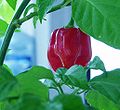Scoville scale
Scoville scale[edit]
The Scoville scale is a measure of the "hotness" of a chili pepper or other spicy food. It is named after Wilbur Scoville, who developed the test in 1912. The scale measures the concentration of capsaicin, the chemical compound responsible for the pungency of peppers.
The heat of a chili pepper is measured in Scoville heat units (SHU). The higher the number of Scoville units, the hotter the pepper. A sweet bell pepper has a Scoville rating of 0, while the Carolina Reaper, one of the hottest peppers in the world, has a Scoville rating of over 2 million.
The Scoville scale is a subjective measure, as it relies on human taste buds to determine the heat level of a pepper. In the original test, a pepper extract was diluted in sugar water until it was no longer detectable by a panel of taste testers. The number of dilutions required to reach this point was then used to calculate the pepper's Scoville rating.
Today, more accurate methods such as high-performance liquid chromatography are used to measure capsaicin concentration. Despite its limitations, the Scoville scale remains a popular way to measure and compare the heat levels of different peppers.
Uses[edit]
The Scoville scale is commonly used by hot sauce and pepper manufacturers to label the heat level of their products. It is also used in the culinary world to help chefs choose the right peppers for their dishes.
Some people enjoy the sensation of spiciness and seek out hot peppers and sauces for their heat. Others may use spicy foods for their perceived health benefits, such as boosting metabolism or reducing inflammation. In some cultures, spicy foods are also believed to have aphrodisiac properties.
Health effects[edit]
Consuming spicy foods can have both positive and negative health effects. Capsaicin, the compound responsible for the heat in peppers, has been shown to have anti-inflammatory and pain-relieving properties. It may also help to boost metabolism and aid in weight loss.
However, for some people, consuming spicy foods can cause discomfort, heartburn, or even gastrointestinal issues. Those with certain medical conditions such as acid reflux or irritable bowel syndrome may need to avoid or limit their intake of spicy foods.
Cultural significance[edit]
Peppers and spicy foods have played an important role in many cultures throughout history. The use of chili peppers in Mexican cuisine, for example, dates back to the pre-Columbian era. In many Asian cultures, spicy foods are believed to help cool the body in hot weather.
In addition to their culinary uses, peppers have also been used for medicinal and spiritual purposes. The ancient Aztecs believed that chili peppers were a gift from the gods, and used them to treat a variety of ailments. In India, the spicy blend of herbs and spices known as garam masala is used in traditional Ayurvedic medicine.
Today, the popularity of spicy foods continues to grow, with new hot sauces and pepper varieties being developed and enjoyed by people around the world.
See also[edit]
External links[edit]
-
Peppers with Scoville scale at Central Market, Houston, TX
-
Bhut Jolokia
-
Naga Jolokia chili
-
Red Savina
-
Capsaicin pharmacophore
Ad. Transform your life with W8MD's Budget GLP-1 injections from $75


W8MD offers a medical weight loss program to lose weight in Philadelphia. Our physician-supervised medical weight loss provides:
- Weight loss injections in NYC (generic and brand names):
- Zepbound / Mounjaro, Wegovy / Ozempic, Saxenda
- Most insurances accepted or discounted self-pay rates. We will obtain insurance prior authorizations if needed.
- Generic GLP1 weight loss injections from $75 for the starting dose.
- Also offer prescription weight loss medications including Phentermine, Qsymia, Diethylpropion, Contrave etc.
NYC weight loss doctor appointmentsNYC weight loss doctor appointments
Start your NYC weight loss journey today at our NYC medical weight loss and Philadelphia medical weight loss clinics.
- Call 718-946-5500 to lose weight in NYC or for medical weight loss in Philadelphia 215-676-2334.
- Tags:NYC medical weight loss, Philadelphia lose weight Zepbound NYC, Budget GLP1 weight loss injections, Wegovy Philadelphia, Wegovy NYC, Philadelphia medical weight loss, Brookly weight loss and Wegovy NYC
|
WikiMD's Wellness Encyclopedia |
| Let Food Be Thy Medicine Medicine Thy Food - Hippocrates |
Medical Disclaimer: WikiMD is not a substitute for professional medical advice. The information on WikiMD is provided as an information resource only, may be incorrect, outdated or misleading, and is not to be used or relied on for any diagnostic or treatment purposes. Please consult your health care provider before making any healthcare decisions or for guidance about a specific medical condition. WikiMD expressly disclaims responsibility, and shall have no liability, for any damages, loss, injury, or liability whatsoever suffered as a result of your reliance on the information contained in this site. By visiting this site you agree to the foregoing terms and conditions, which may from time to time be changed or supplemented by WikiMD. If you do not agree to the foregoing terms and conditions, you should not enter or use this site. See full disclaimer.
Credits:Most images are courtesy of Wikimedia commons, and templates, categories Wikipedia, licensed under CC BY SA or similar.
Translate this page: - East Asian
中文,
日本,
한국어,
South Asian
हिन्दी,
தமிழ்,
తెలుగు,
Urdu,
ಕನ್ನಡ,
Southeast Asian
Indonesian,
Vietnamese,
Thai,
မြန်မာဘာသာ,
বাংলা
European
español,
Deutsch,
français,
Greek,
português do Brasil,
polski,
română,
русский,
Nederlands,
norsk,
svenska,
suomi,
Italian
Middle Eastern & African
عربى,
Turkish,
Persian,
Hebrew,
Afrikaans,
isiZulu,
Kiswahili,
Other
Bulgarian,
Hungarian,
Czech,
Swedish,
മലയാളം,
मराठी,
ਪੰਜਾਬੀ,
ગુજરાતી,
Portuguese,
Ukrainian




